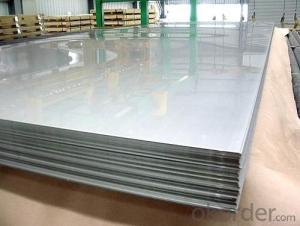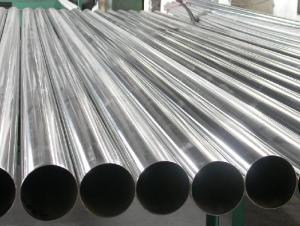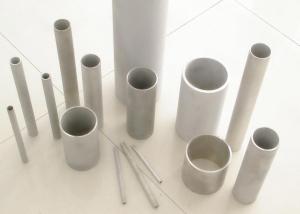STAINLESS STEEL COIL 304 HOT ROLLED
- Loading Port:
- Shanghai
- Payment Terms:
- TT OR LC
- Min Order Qty:
- -
- Supply Capability:
- 5000 m.t./month
OKorder Service Pledge
Quality Product, Order Online Tracking, Timely Delivery
OKorder Financial Service
Credit Rating, Credit Services, Credit Purchasing
You Might Also Like
grade | 201,304,316,430,420,410,ETC. |
surface | NO.1 |
thickness | 1MM,2MM,3MM,4MM,5MM,6MM,ETC. |
width | 1200MM,1220MM,1500MM,ETC. |
length | 2400MM,2440MM,3000MM,ETC. |
Payment terms | T/T, or L/C. |
Delivery time | Normally within 1 weeks after get your deposits. |
package | Standard export package, normally with wooden pallets |
MOQ | 5 tons/each size |
we can provide the best-quality ,and shortest producing time.
we have the hot rolled and cold rolled for stainless steel sheet/coil,etc.
please feel free to contact me, thanks in advance !
- Q: Are stainless steel sheets suitable for roofing applications?
- Yes, stainless steel sheets are suitable for roofing applications. They are durable, corrosion-resistant, and provide excellent strength and longevity. Additionally, stainless steel sheets offer good aesthetic appeal and can withstand harsh weather conditions, making them a reliable choice for roofing projects.
- Q: What is the maximum thickness of a stainless steel sheet?
- The maximum thickness of a stainless steel sheet can vary depending on the specific grade or type of stainless steel being used. In general, stainless steel sheets can range from as thin as 0.4 millimeters (0.0157 inches) to as thick as 100 millimeters (3.937 inches) or more. However, it is important to note that the availability of thicker sheets may be limited and can vary based on the supplier or manufacturer. Additionally, some stainless steel alloys may have different thickness limits due to their composition and intended use. Therefore, it is always recommended to consult with a supplier or refer to the specifications provided by the manufacturer to determine the maximum thickness of the specific stainless steel sheet you require.
- Q: Can stainless steel sheets be used for cladding?
- Indeed, cladding can utilize stainless steel sheets. The preference for stainless steel as a cladding material stems from its robustness, ability to withstand corrosion, and visual allure. It is frequently employed in the external cladding of structures, including facades, canopies, and curtain walls. Stainless steel sheets provide an elegant and contemporary look while furnishing defense against severe environmental circumstances. Furthermore, stainless steel cladding necessitates minimal upkeep, boasts an extended lifespan, and can be effortlessly cleaned, rendering it a pragmatic selection for both residential and commercial purposes.
- Q: Are stainless steel sheets suitable for chemical processing plants?
- Chemical processing plants find stainless steel sheets highly suitable. The reason lies in the excellent corrosion resistance that stainless steel offers, making it the ideal choice for environments with chemicals. It can resist a wide range of chemicals, including acids, alkalis, and solvents, which are commonly present in chemical processing plants. Moreover, stainless steel sheets provide high strength and durability, enabling them to endure harsh operating conditions and maintain their structural integrity over time. They are also easy to clean and maintain, ensuring a hygienic environment in chemical processing plants. Furthermore, stainless steel sheets possess favorable thermal properties, making them appropriate for applications involving extreme temperatures. Additionally, they have low magnetic permeability, which proves advantageous in certain chemical processing operations. All in all, stainless steel sheets are a favored option in chemical processing plants due to their corrosion resistance, strength, durability, and ease of maintenance.
- Q: Are stainless steel sheets suitable for medical equipment or devices?
- Yes, stainless steel sheets are commonly used in the manufacturing of medical equipment or devices due to their excellent corrosion resistance, durability, ease of cleaning, and ability to withstand sterilization processes.
- Q: Are stainless steel sheets suitable for automotive grilles or trim?
- Yes, stainless steel sheets are suitable for automotive grilles or trim due to their durability, corrosion resistance, and ability to withstand harsh weather conditions.
- Q: Can stainless steel sheets be used in chemical processing plants?
- Yes, stainless steel sheets can be used in chemical processing plants. Stainless steel is highly resistant to corrosion, making it an ideal material for use in environments where chemicals are present. It can withstand exposure to a wide range of chemicals, including acids, alkalis, and solvents, without deteriorating or reacting with them. Stainless steel sheets are also easy to clean and maintain, ensuring that they meet the strict hygiene and safety standards required in chemical processing plants. Additionally, stainless steel has excellent strength and durability, making it suitable for various applications within the plant, such as tanks, piping, pressure vessels, and heat exchangers. Overall, stainless steel sheets are a reliable and versatile choice for use in chemical processing plants.
- Q: Can stainless steel sheets be used for elevator frames?
- Indeed, elevator frames can be constructed using stainless steel sheets. Renowned for its durability, strength, and resistance to corrosion, stainless steel proves itself as an excellent choice for numerous purposes, including elevator frames. By employing stainless steel sheets, elevator frames acquire a lasting and visually appealing structure that withstands the rigors of daily usage. Moreover, stainless steel's sleek and contemporary appearance elevates the overall elevator design, imparting a refined and fashionable allure.
- Q: Can stainless steel sheets be used for aerospace fasteners?
- Yes, stainless steel sheets can be used for aerospace fasteners. Stainless steel is a popular choice for aerospace applications due to its excellent corrosion resistance, high strength, and durability. It can withstand extreme temperatures and environments, making it suitable for use in aircraft components that are exposed to challenging conditions. Stainless steel sheets can be fabricated into various shapes and sizes to serve as fasteners such as screws, bolts, and rivets, providing a reliable and secure connection in aerospace structures. Additionally, stainless steel's non-magnetic properties are advantageous for certain aerospace applications where magnetic interference needs to be minimized. Overall, stainless steel sheets are a reliable and widely used material for aerospace fasteners.
- Q: How do I determine the size and dimensions for stainless steel sheets?
- To determine the size and dimensions for stainless steel sheets, you need to consider a few factors. Firstly, think about the specific application or project for which you need the stainless steel sheets. This will help you determine the required size and dimensions based on the purpose and function of the sheets. Next, consider the specific dimensions you need in terms of length, width, and thickness. Stainless steel sheets are typically available in standard sizes, so it's important to know the required measurements beforehand. You can also consult with suppliers or manufacturers who specialize in stainless steel sheets. They can provide guidance and assistance in determining the appropriate size and dimensions based on your specific requirements. Additionally, they may have a range of sizes available in stock that can be tailored to meet your needs. Furthermore, it's crucial to consider any additional factors that may affect the size and dimensions of the stainless steel sheets. This includes factors such as weight restrictions, installation requirements, and compatibility with other components or materials. Overall, determining the size and dimensions for stainless steel sheets requires careful consideration of the application, specific measurements, and consultation with experts in the field.
Send your message to us
STAINLESS STEEL COIL 304 HOT ROLLED
- Loading Port:
- Shanghai
- Payment Terms:
- TT OR LC
- Min Order Qty:
- -
- Supply Capability:
- 5000 m.t./month
OKorder Service Pledge
Quality Product, Order Online Tracking, Timely Delivery
OKorder Financial Service
Credit Rating, Credit Services, Credit Purchasing
Similar products
Hot products
Hot Searches
Related keywords
























